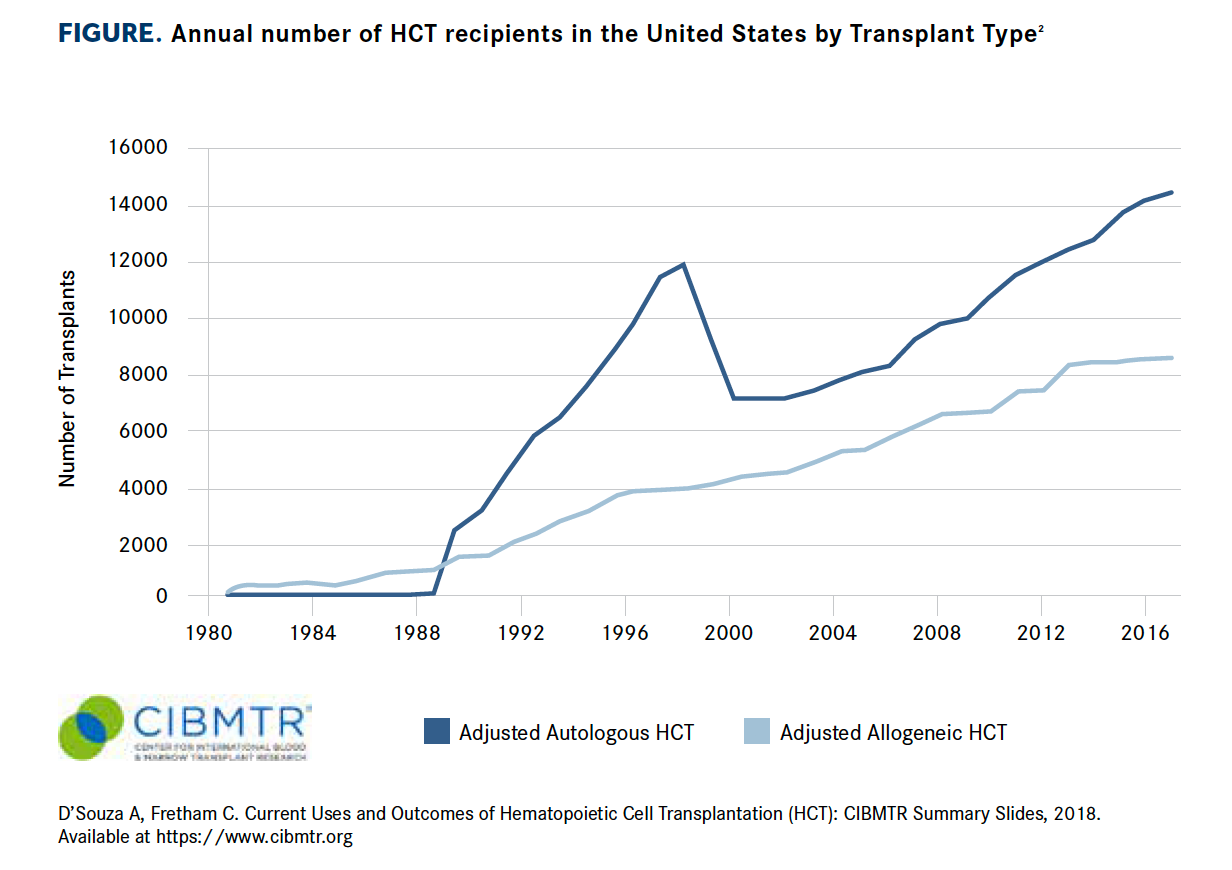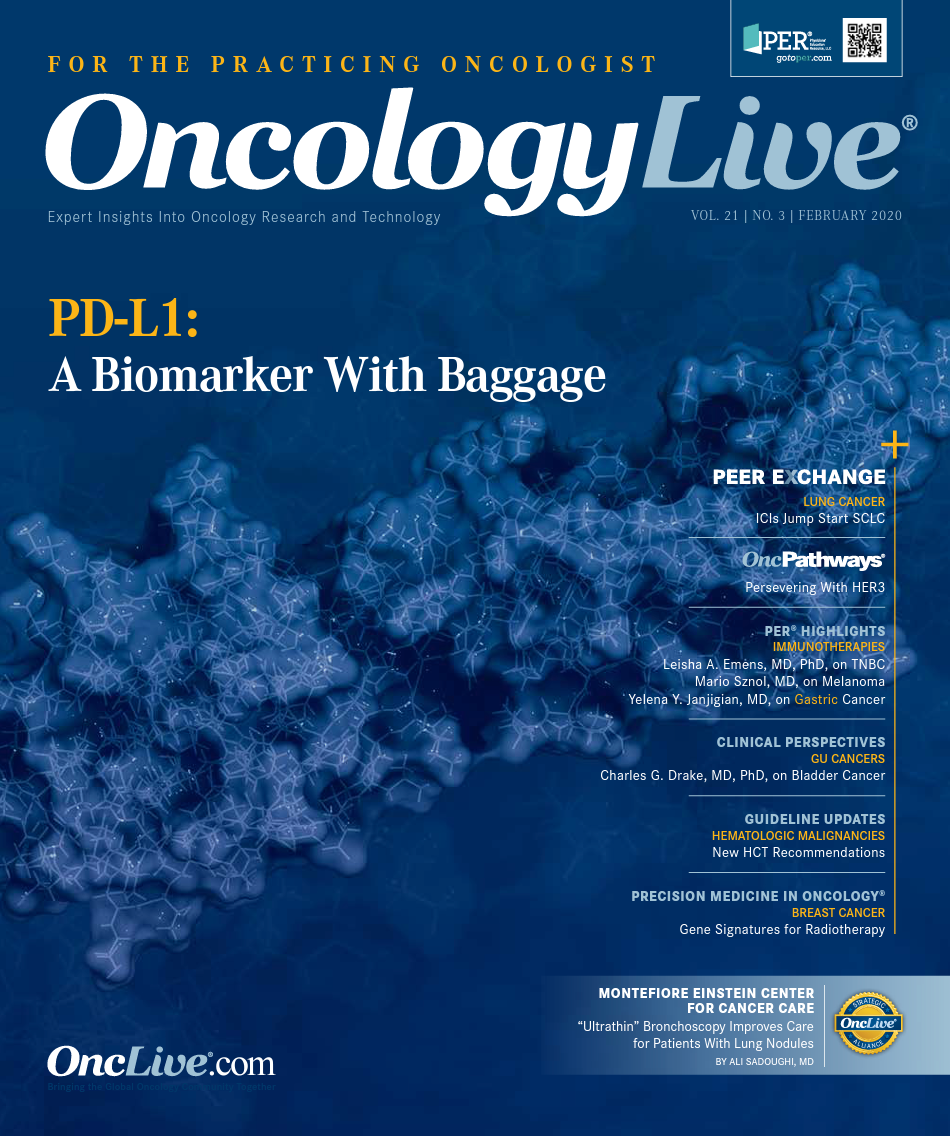Publication
Article
Oncology Live®
Inaugural HCT Guideline Focuses on Patient Selection, GVHD Treatment
Author(s):
In response to a rise in hematopoietic cell transplantation, the National Comprehensive Cancer Network has published its first guideline for the specialized intervention, which is performed approximately 22,000 times a year in the United States in patients with hematological cancers and other diseases.
Ayman A. Saad, MD, MSc, chair of the NCCN guidelines panel for HCT

Ayman A. Saad, MD, MSc
In response to a rise in hematopoietic cell transplantation (HCT), the National Comprehensive Cancer Network (NCCN) has published its first guideline for the specialized intervention, which is performed approximately 22,000 times a year in the United States in patients with hematological cancers and other diseases.1
Panelists hope that the guideline, which focuses on pretransplant evaluation, posttransplant patient follow-up, and strategies to manage graft-versus-host disease (GVHD), will help oncologists become more familiar with this lifesaving modality and how to select patients for HCT.
“Each day, the donor pool grows, and with it grows the chance that we will be able to find [an allogeneic] graft for a patient undergoing transplant,” said Ayman A. Saad, MD, MSc, chair of the NCCN guidelines panel for HCT.
The rising frequency of HCT, also known as stem cell or bone marrow transplant, is due in part to a spike in the number of blood and bone marrow donors registering with the National Marrow Donor Program’s Be The Match Registry, according to Saad (Figure).2
Figure. Annual number of HCT recipients in the United States by Transplant Type (Click to Enlarge)

Advances in transplantation modalities have also contributed to the increase in HCT procedures performed. For example, the development of haploidentical transplantation has expanded the number of patients who can safely receive a transplant, Saad said.
In haploidentical transplants, hematopoietic cells are procured from a family donor who matches half of the human leukocyte antigen (HLA) markers of the patient. In contrast, HLA-matched unrelated (nonidentical) donor transplants require tissue typing of the patient’s blood and a subsequent search of international registries to identify a complete match with an unrelated donor.3
“About 10 to 20 years ago, transplants were not common among people older than 70, but now there are ways to carry out transplantation for elderly patients,” said Saad, a professor of clinical medicine at The Ohio State University Comprehensive Cancer Center—James Cancer Hospital and Solove Research Institute in Columbus, Ohio.
However, the expanding use of HCT is only part of the NCCN’s rationale for drafting the guideline. “The practice of transplant has been continuously updated over the past 5 decades, with new approaches steadily emerging,” Saad said. “The practice of transplant is very diverse, not only in the United States but also all over the world.”
The existence of multiple HCT methods, such as autologous HCT, syngeneic transplantation, and allogeneic transplantation, created the need for standardized best practices for this procedure, Saad said. HCT is a marrow- and immune-function-restoring treatment that intravenously delivers hematopoietic cells to the recipient. Hematopoietic cells are sourced from either bone marrow or peripheral blood. The availability of a donor and the patient’s age and disease influence the type of HCT that is therapeutically pursued.3
HCT is used in blood cancers, including leukemia, lymphoma, and myeloma; nonmalignant acquired bone marrow disorders; and genetic diseases associated with abnormal hematopoiesis and function.3 Often, transplant is “the only cure for many of these diseases,” according to Alison W. Loren, MD, MSCE, a member of the NCCN HCT guidelines panel.
Most of the guideline’s recommendations are supported by category 2A evidence, signifying uniform NCCN consensus that the selected intervention is appropriate based on lower-level evidence.4
The HCT guidelines panel included 27 hematologists/oncologists, transplantspecific practitioners, and infectious disease specialists from leading academic cancer centers. Panelists sought to produce a set of recommendations that would “streamline the way transplant is done in North America,” Saad said.
Pretransplant Patient Evaluation and Posttransplant Follow-Up
The guideline gives direction on how to evaluate a potential transplant recipient to determine whether the patient is eligible for the procedure. This component of the consensus statement is particularly important because “early referral for HCT consideration can be lifesaving,” said Loren, who is also the director of blood and marrow transplantation at the Abramson Cancer Center and vice chair of faculty development in the Department of Medicine at the Perelman School of Medicine of the University of Pennsylvania in Philadelphia, Pennsylvania.
“Allogeneic transplants are usually done in large tertiary centers, so we depend on community oncologists to refer patients for transplant,” Loren said.
Both Loren and Saad expressed hope that the guideline will help coordinate the work of general oncologists and transplantation specialists. “These guidelines can raise awareness among our colleagues not only [about] when to refer patients for HCT but also about what we do,” Saad said.
This cooperation can help optimize the outcomes of patients who are candidates for HCT and is “critical for patient follow-up,” according to Saad, because a patient’s time is often split between the transplant center and the referring oncologist.
The guideline’s authors address the clinical assessment, imaging, and laboratory tests that can be used in the pretransplant evaluation. The pretransplant examination of the patient, the guideline notes, “generates data to estimate risks of posttransplant complications” such as nonrelapse mortality. It also yields information that can guide the selection of preparative therapies, including drug choice, dose intensity, and specific immunosuppressive regimen.4
In the clinical assessment stage, the NCCN recommends bone marrow aspiration and biopsy to confirm the patient’s remission status and to rule out other diseases. The guideline also recommends pulmonary function tests, psychosocial evaluation, and HCT comorbidity index scoring, among other measures.4
Imaging may entail a chest x-ray. Laboratory tests comprise urinalysis, infectious disease testing, and a chemistry profile, in addition to other evaluations. Additional clinical assessments, imaging, and laboratory testing may be pursued as clinically indicated.4
Regarding posttransplant follow-up, the guideline supports monitoring for complications including GVHD, infection, and disease relapse. “Additional recommendations for post-HCT follow-up will be addressed in subsequent versions” of the guideline, the authors wrote.4
Treating GVHD
Developing an algorithm to standardize the management of GVHD in HCT recipients was one of the panel’s objectives because, just as there are many different ways to perform transplants, there “are many different ways to treat GVHD,” said Saad, who added that there may be as many as 10 to 20 approaches.
The profusion of therapeutic options to address GVHD is a relatively new development, according to Loren. “For many years, we had no approved treatments for GVHD other than steroids. However, in the past few years there’s been a real deepening of our understanding of the biology of GVHD, which has resulted in more research and more therapies for this condition.
“This is a really exciting time in GVHD; there are new clinical trials and drugs that have either been approved or are coming down the pike. We want to make oncologists aware of the different manifestations of GVHD and also alert them that there has been progress and there are several treatments to consider,” she added.
GVHD is an adverse event of allogeneic transplant that occurs when the donor’s T cells, clinically known as “the graft,” perceive the recipient’s healthy cells as foreign and attack them. The condition ranges from mild to severe and can be life threatening.5
The HCT guideline stratifies GVHD by manifestation (acute, chronic, and/or steroid refractory) and offers treatment recommendations for each type of GVHD.
Acute and Chronic GVHD
If acute GVHD (aGVHD) is suspected, the panelists recommend conducting tests to rule out non-GVHD causes. Additionally, an organ-directed biopsy may be performed as clinically indicated to confirm the presence of aGVHD, along with liver function tests and determination of the GVHD stage and grade because treatment varies by stage. Keystone (modified Glucksberg) criteria, the authors note, are commonly used for the staging and grading of aGVHD in adults.4
First-line treatment for grade 1 aGVHD includes administration of an immunosuppressive agent, in addition to either topical steroids (used until the patient’s rash subsides) or observation (if the patient is asymptomatic or if the rash is stable).4
If the patient does not respond, participation in a clinical trial or continuation of topical steroids is recommended. Alternatively, if there is an observable response, defined as the resolution of the rash or other symptoms, the immunosuppressive agent should be tapered “as clinically feasible.” If the patient’s condition progresses beyond grade 1, guidance for the management of grade 2 to 4 aGVHD should be consulted.4
When diagnosing chronic GVHD (cGVHD), oncologists should first confirm that the condition is chronic and then determine the grade. The guideline contains an organ scoring sheet that includes body range-of-motion photographs to aid in the assessment of patient mobility.
Signs and symptoms of cGVHD can present across multiple organ sites, such as the skin, nails, and scalp. For this reason, the guideline includes a comprehensive list of common indicators of cGVHD, such as depigmentation, dystrophy, and scaling.4
First-line treatment recommendations for cGVHD include enrollment in a clinical trial or use of an immunosuppressive agent with systemic corticosteroids. Corticosteroids may be given in place of an immunosuppressive drug. Topical steroids can also be administered as clinically indicated and inhaled steroids with or without azithromycin can be used for lung involvement, if necessary. For patients who respond, oncologists should taper steroids as clinically feasible.
A lack of response indicates steroidrefractory disease. Choices for these patients include participation in a clinical trial or the addition of a systemic agent to corticosteroids with steroid tapering.4
Steroidrefractory GVHD
High-dose systemic corticosteroids are a staple of first-line GVHD treatment and elicit durable complete responses in 30% to 40% of patients. However, GVHD that becomes refractory to steroid-based therapy is associated with increased mortality for patients who develop the condition post transplant. Notably, mortality rates for patients with steroid-refractory aGVHD can be as high as 80%.6
The NCCN HCT guideline outlines the National Institutes of Health response criteria to measure steroid response in clinical trials in aGVHD and cGVHD. Three definitions are included: steroid refractoriness or resistance, steroid dependence, and steroid intolerance. Also provided are cGVHD steroid response criteria, which include indicators of progression and of complete and partial responses.4
The panel encourages patients with steroid-refractory GVHD to participate in clinical trials; additionally, it suggests several systemic agents for steroid-refractory GVHD in both its acute and chronic manifestations. The guideline states that the drugs “are the most commonly used agents among the NCCN member institutions” and recommends that they be given with corticosteroids. A lack of evidence demonstrating the superiority of one systemic therapy over another precludes the panel from supporting the use of one particular agent versus another.4
Some of the agents available for the treatment of steroid-refractory aGVHD are alemtuzumab (Lemtrada), etanercept (Enbrel), infliximab (Remicade), and ruxolitinib (Jakafi). Of note, the FDA approved ruxolitinib for steroid-refractory aGVHD for adult and pediatric patients ≥12 years in May 2019.7
For steroid-refractory cGVHD, available agents include ibrutinib (Imbruvica), rituximab (Rituxan), low-dose methotrexate, and abatacept (Orencia), among others. Ibrutinib is the first therapy specifically approved for cGVHD. In August 2017, the FDA okayed the use of ibrutinib monotherapy in patients with cGVHD who have failed ≥1 lines of systemic therapy.8
Factors that should guide the selection of a systemic agent for steroid-refractory GVHD include institutional preferences, physician experience, toxicity, drug interactions, convenience/ accessibility, patient tolerability, and the effect of prior treatment.4
Further Development
The discussion section for the HCT guideline is forthcoming and will be followed by other HCT-related care recommendations. “Additional topics will be addressed in subsequent versions,” the authors wrote.4
Although the guideline puts forth focused suggestions for pretransplant recipient evaluation, posttransplant follow-up, and GVHD management, these areas are only part of the HCT equation, Saad said. “There is still a lot to be accomplished with this guideline, and I am hoping to [expand it] it in the coming year because we did not include information on regimen, selection, and complications other than GVHD,” Saad said. “We think this is a starting point.”
References
- New NCCN guidelines debut to manage complications and improve readiness for stem cell transplant [news release]. Plymouth Meeting, PA: National Comprehensive Cancer Network; October 30, 2019. ptcommunity.com/wire/new-nccn-guidelines-debut-manage-complications-and-improve-readiness-stem-cell-transplant. Accessed November 13, 2019.
- D’Souza A, Lee S, Zhu X, Pasquini M. Current use and trends in hematopoietic cell transplantation in the United States. Biol Blood Marrow Transplant. 2017;23(9): 1417-1421. doi: 10.1016/j.bbmt.2017.05.035.
- Forman SJ, Nakamura R. Hematopoietic cell transplantation. Cancernetwork website. cancernetwork.com/cancer-management/hematopoietic-cell-transplantation. Published November 1, 2015. Accessed November 15, 2019.
- NCCN Clinical Practice Guidelines in Oncology. Hematopoietic Cell Transplantation (HCT): Pre-Transplant Recipient Evaluation and Management of Graft-Versus-Host Disease, version 1.2020. National Comprehensive Cancer Network website. https://www.nccn.org/store/login/login.aspx?ReturnURL=https://www.nccn.org/professionals/physician_gls/pdf/hct.pdf. Published October 30, 2019. Accessed November 13, 2019.
- Graft-versus-host disease. Leukemia & Lymphoma Society website. lls.org/treatment/types-of-treatment/stem-cell-transplantation/graft-versus-host-disease. Accessed November 14, 2019.
- Česen Mazič M, Girandon L, Knezevič M, Avčin SL, Jazbec J. Treatment of severe steroid-refractory acute-graft-vs.-host-disease with mesenchymal stem cells—single center experience. Front Bioeng Biotechnol. 2018;6:93. doi: 10.3389/fbioe.2018.00093.
- Jakafi [prescribing information]. Alapocas, DE: Incyte Corporation; 2019. accessdata.fda.gov/drugsatfda_docs/label/2019/202192s017lbl.pdf. Accessed January 23, 2020.
- Imbruvica [prescribing information]. Sunnyvale, CA: Pharmacyclics LLC; 2017. accessdata.fda.gov/drugsatfda_docs/label/2017/205552s017lbl.pdf. Accessed January 23, 2020.










